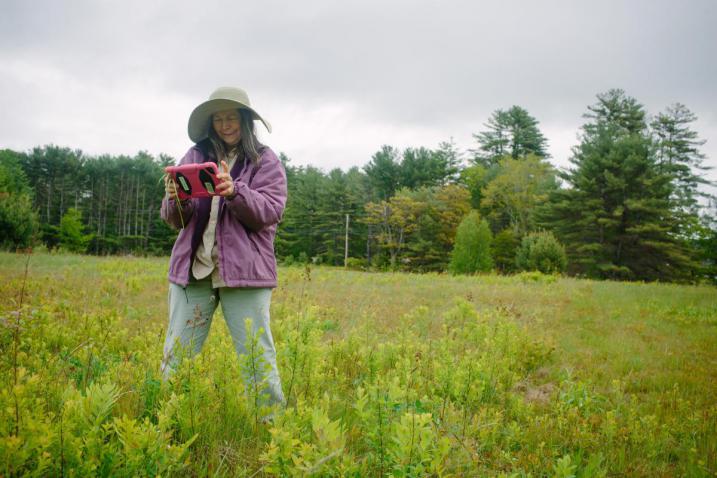10 Cool Ideas from the Citizen Science 2017 Conference
The Citizen Science Association held its second conference in St. Paul, Minnesota in May, 2017. We know most of our citizen science colleagues here in New England couldn’t make the trip, so a few of us from UNH Extension and NH Sea Grant who attended are sharing our Top Ten Cool Ideas that we took away from the conference. If this is your dream conference, keep in mind it’s scheduled to happen again in 2019 in North Carolina, so stay tuned!
Malin's Picks
1. Public libraries can make great partners for citizen science - We learned of some great examples of citizen science programs partnering with public and university libraries. Libraries are about democratizing access to knowledge, building science literacy, participatory learning, and building community – all great fits for citizen science! Finding a (staff) champion within the library is key. We learned about projects like #WolfPackCitSci at North Carolina State Library that introduced new people to citizen science and new people into the libraries. Check out Twitter feeds for #CitSciLibraries or or North Carolina State’s library page on citizen science.
2. Citizen science can lead to behavior change by participants – Bee researchers at San Francisco State University established The Great Sunflower Project in 2008 as a way to gather information about urban, suburban and rural bee populations in the U.S, and to give people the tools to learn about what is happening with the pollinators in their backyards. They’ve learned that 75% of those involved in the online reporting project changed their behavior to make their backyards and properties more bee-friendly.
3. National Parks have adopted the BioBlitz to educate students in science – For those planning your own bioblitz, you can learn a lot from National Park bioblitz resources developed by National Geographic that ensure strong learning outcomes for schools, teachers, and the public. Check out “Designing a BioBlitz Learning Experience.”
Caitlin's Picks
Caitlin Peterson is a former staff member with NH Sea Grant and UNH Extension
4. Students can learn and collect valuable data at the same time – Citizen science and classroom learning seem like a natural pairing – after all, what better way to learn about science than by participating in it? But designing lesson plans to match national curriculum standards is not easy. Enter Students Discover! This project pairs citizen science projects with lesson plans developed by specialists in K-12 education. Each lesson plan is easy to follow, with a clearly outlined alignment with national curriculum standards. Great inspiration for both teachers and citizen science programs considering partnerships!
5. Volunteers teaching volunteers can produce powerful results – Researchers at the University of Maryland developed the Watershed Stewards Academy to empower community members to lead their communities in addressing water quality issues. They found that communities come together to participate in citizen science and stewardship more easily when they are led by fellow citizen scientists than when they are instructed by science professionals alone.
6. Citizen science is truly a global movement! – One session of the conference was devoted to sharing stories of citizen science from around the world. We can’t possibly fit all of these stories into this article, but for some inspiration, browse the websites of the European Citizen Science Association and the Australian Citizen Science Association, check out this podcast on the growing citizen science movement in China, and read through the symposium report from last year’s East African citizen science symposium in Nairobi, Kenya. If you participate in citizen science, you’re part of this global movement!
Alyson's Picks
7. Citizen scientists can contribute along a spectrum of participation - Research out of Virginia Tech found that a primary reason that citizen scientists drop out of projects is the time commitment. How can we fix this? Be clear about the expected time commitment when advertising citizen science opportunities. If possible, provide different roles and levels of involvement within your projects.
8. Citizen science programs benefit in many ways from working with volunteers - Citizen science programs should work to incorporate the “lived lives” (i.e., personal observations and experiences) of volunteers into data collection, particularly with place-based efforts. Citizen scientists can provide important real world context and observations to research programs! Rocky Mountain Wild issued a simple survey to their Pika Project volunteers asking questions about the program format. Volunteers shared such suggestions as the need to consolidate field trips to lesson strenuous mountain hiking. The project tweaked their program structure and increased their volunteer retention from 35 to 70%!
9. The citizen science movement is creating better access to research tools and hardware - Scientific research often requires tools and hardware that are expensive or difficult to obtain, creating a barrier for the public to participate. Groups such as Public Lab are bringing together people focused on developing open source, low cost tools for environmental monitoring. If you’re interested in exploring low cost methods to monitor air, water or land, check out the tools and methods developed by the Public Lab community.
10. It’s all about partnership - Mutual respect is critical to successful citizen scientist -researcher collaborations. This was a theme we heard throughout the conference, but nowhere was this more strongly issueed than in the keynote speech delivered by LeeAnne Walters and Marc Edwards, the citizen scientist-research team behind the Flint Water Crisis. The Flint backstory is a complicated one that exposed many flaws in the way regulatory oversight and science intersect, but the story also showcases the success of the Walters-Edwards partnership which, according to Dr. Edwards, was successful due to their mutual “trust and respect.” Check out a Smithsonian article about their partnership.



